DSCSA 2024 Ten Count: Number 6-Exception Handling Building Resilient Processes

Ten Count Consulting reflects on 2024 with our list of top DSCSA moments and stories from 2024.
DSCSA Exception Handling: Building Resilient Processes for 2025 and Beyond

The FDA's stabilization period aimed to give trading partners the opportunity to build and validate interoperable systems, manage products and data effectively, and ensure the continuous availability of products for patients. Throughout 2024, distributors significantly increased their efforts to receive serialized products and reconcile product data. As data utilization expanded downstream, differences between physical products and digital records became more evident. This post explores exception-handling practices, informed by the latest guidelines, pilot studies, and industry discussions.
Understanding DSCSA Exceptions
Exceptions occur when there is a mismatch between physical products and their associated digital transaction or initiating master data. Common exception categories include:
- Product, No Data: Physical product is received without corresponding transaction data (such as Electronic Product Code Information Services (EPCIS) or other interoperable electronic data).
- Data, No Product: Transactional data is received, but the physical product is missing.
- Other Discrepancies: Where the data misalignment comes from other challenges, such as incomplete/inaccurate master data or barcoding issues.
As highlighted in the previous post on the DSCSA Stabilization Period Checkpoint PDG-FDA Joint Public Meeting, achieving 100% data accuracy is unrealistic. Given the enormous volume of unit-level transactions, errors are inevitable. Therefore, the focus must shift to developing well-controlled, risk-based processes that effectively manage these discrepancies and prevent their recurrence.
Key Principles for Exception Management
- Prioritize Legitimate Product Movement: Minimize disruptions to avoid product shortages.
- Implement Structured, Risk-Based Processes: Relying on reactive, ad-hoc solutions is unsustainable. A formal system involving cross-functional teams and clearly defined workflows is essential.
- Thorough Documentation: Maintain comprehensive records of exceptions and resolutions to meet regulatory requirements.
- Foster Effective Collaboration: Timely communication between trading partners is critical for resolving issues.
Links to Industry Guidelines, Pilot Studies, and Work Groups on Exceptions
Exception handling requires a solid alignment with trading partners and the industry on how each scenario of exceptions should be handled. While exceptions often require real-time analysis to understand the root causes and resolutions, most exceptions are experienced across the industry and can benefit from good planning and continuous improvement. These are some of the more common publications that outline industry work done to date:
HDA Publications- Exception Handling for DSCSA:
- Exceptions Handling Guidelines For the DSCSA (Version 2.0 published October 2023 need to be downloaded from website)
- DSCSA Exceptions Handling Communication Guide (published 2024)
- Exceptions Data Correction Guide for DSCSA (published October 2024)
Partnership for DSCSA Governance (PDG) Root Causes Document
Developing Robust Exception Handling Systems
As industry-independent exploration in late 2024 shifted towards exploring building sustainable exception-handling processes, key considerations emerged:
Identify Input Sources and Engage Stakeholders:
- Where do data elements enter the data flow?
- Which internal and external stakeholders are involved?
- Are expectations with external stakeholders clearly spelled out in contractual or business agreements?
- How is data transferred between internal systems, and what interventions could disrupt this flow?
Streamline Initial Intake Processes:
- Which communication channels could receive exception notifications from suppliers and or customers?
- How will documentation and resolution statuses be tracked and made visible to key stakeholders?
- What critical information must be collected during intake?
- How will exceptions be prioritized and risk assessed?
Establish Clear Resolution and Escalation Paths:
- Which exceptions fall under cGMP guidelines?
- When should Quality Management Systems (QMS) be involved?
- What tools can automate error detection during receiving and shipping?
- Can reconciliation reports and automated alerts reduce manual interventions?
Implement Preventive Measures:
- Are processes aligned with industry standards (HDA, GS1) to minimize errors?
- Are regular audits of EPCIS data exchanges conducted?
- Are staff trained to identify and address exceptions promptly?
Create Feedback Loops:
- How can trading partners share insights to improve processes?
- Are lessons from past exceptions informing system and policy updates?
This is not an exhaustive list but highlights critical steps and questions for strengthening exception management as we move into 2025.
Conclusion
Exception handling is essential for DSCSA compliance, demanding vigilance, collaboration, and adaptability to evolving standards. By engaging in industry dialogue, adopting best practices, and leveraging available tools, trading partners can safeguard the efficient and secure movement of products throughout the supply chain.
Ten Count Consulting is here to guide your organization in developing and implementing effective DSCSA exception-handling strategies to ensure compliance and supply chain integrity. In addition to developing robust exception-handling systems and processes, organizations need to ensure they have the proper resources to execute them. Depending on the volume of transactions being managed, resources can be stretched thin and often be overwhelmed by the complexity of DSCSA exceptions. Without the proper context and experience, exception handling can be a full-time job (or more). Reach out to us if you would like an independent perspective on the tools and services that are available in these areas.
The List Revealed So Far:
Number 9: FDA 483s Issued for DSCSA Requirements
Number 8: Two-Year Exemption for Small Dispensers
Number 7: DSCSA Stabilization Period Checkpoint PDG-FDA Joint Public Meeting
Stay tuned to our blog over the coming days as we share the remaining 5 highlights of 2024!
Number 5
Number 4
Number 3
Number 2
Number 1




